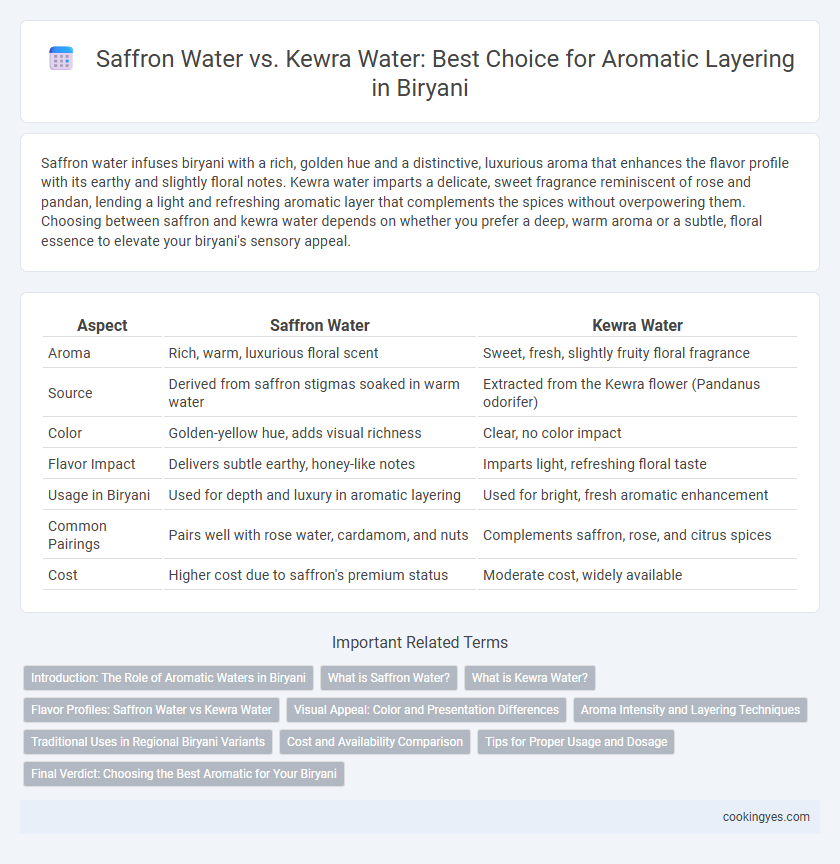Saffron water infuses biryani with a rich, golden hue and a distinctive, luxurious aroma that enhances the flavor profile with its earthy and slightly floral notes. Kewra water imparts a delicate, sweet fragrance reminiscent of rose and pandan, lending a light and refreshing aromatic layer that complements the spices without overpowering them. Choosing between saffron and kewra water depends on whether you prefer a deep, warm aroma or a subtle, floral essence to elevate your biryani's sensory appeal.
Table of Comparison
| Aspect | Saffron Water | Kewra Water |
|---|---|---|
| Aroma | Rich, warm, luxurious floral scent | Sweet, fresh, slightly fruity floral fragrance |
| Source | Derived from saffron stigmas soaked in warm water | Extracted from the Kewra flower (Pandanus odorifer) |
| Color | Golden-yellow hue, adds visual richness | Clear, no color impact |
| Flavor Impact | Delivers subtle earthy, honey-like notes | Imparts light, refreshing floral taste |
| Usage in Biryani | Used for depth and luxury in aromatic layering | Used for bright, fresh aromatic enhancement |
| Common Pairings | Pairs well with rose water, cardamom, and nuts | Complements saffron, rose, and citrus spices |
| Cost | Higher cost due to saffron's premium status | Moderate cost, widely available |
Introduction: The Role of Aromatic Waters in Biryani
Saffron water imparts a rich, golden hue and a subtle floral sweetness to biryani, enhancing both the aroma and visual appeal. Kewra water, derived from pandanus flowers, offers a distinctive, fragrant, and slightly fruity scent that complements the spices in biryani. Using these aromatic waters in layering unlocks complex flavors and elevates the sensory experience of traditional biryani dishes.
What is Saffron Water?
Saffron water is a fragrant infusion made by soaking saffron threads in warm water, releasing its rich golden color and distinct aroma essential for enhancing biryani. This natural essence imparts a subtle floral and honey-like scent, elevating the dish's flavor profile while adding a vibrant yellow hue to the rice. Valued for its luxurious taste and aroma, saffron water remains a preferred choice in aromatic layering for authentic biryani recipes.
What is Kewra Water?
Kewra water is a distilled essence extracted from the pandanus flower, known for its sweet, floral fragrance that enhances the aromatic profile of biryani. Its unique scent adds a delicate, exotic layer to the dish, complementing the rich spices and saffron without overpowering them. Unlike saffron water, which imparts a subtle golden color and earthy aroma, kewra water intensifies the floral notes, making it a preferred choice for aromatic layering in traditional biryani recipes.
Flavor Profiles: Saffron Water vs Kewra Water
Saffron water imparts a rich, floral aroma with subtle earthy and honeyed notes, enhancing biryani's depth and color. Kewra water offers a sweeter, more fruity fragrance with delicate rose-like undertones, providing a lighter, refreshing aroma. Selecting between saffron and kewra water depends on desired flavor intensity, where saffron adds warmth and richness, while kewra contributes a crisp and fragrant finish.
Visual Appeal: Color and Presentation Differences
Saffron water imparts a rich golden-yellow hue to biryani, enhancing visual appeal with vibrant color and a luxurious, appetizing presentation. Kewra water, while less impactful on color, adds a subtle sheen that highlights the grains and maintains the biryani's natural appearance. The choice between saffron and kewra water significantly influences the dish's aesthetic, with saffron creating a more vivid and elegant look.
Aroma Intensity and Layering Techniques
Saffron water offers a rich, warm aroma with deep floral and honeyed notes, providing intense aromatic layering in biryani, ideal for infusing both rice and meat evenly. Kewra water delivers a lighter, sweet, and slightly citrusy fragrance, enhancing the top layers with subtle, fresh floral highlights that create a multidimensional sensory experience. Combining saffron water in the cooking liquid and kewra water as a finishing sprinkle intensifies aroma complexity, ensuring each bite holds distinct, layered fragrance nuances.
Traditional Uses in Regional Biryani Variants
Saffron water is traditionally used in Awadhi and Hyderabadi biryanis to impart a rich, golden hue and a subtle floral aroma that enhances the dish's luxurious profile. Kewra water, derived from pandanus flowers, is favored in Malabar and Lucknowi biryanis for its distinctive sweet, fruity fragrance that adds a unique aromatic depth. Regional biryani variants rely on these waters not only for scent but also to reflect cultural heritage and elevate the overall sensory experience.
Cost and Availability Comparison
Saffron water, derived from expensive saffron threads, offers a richer aroma and vibrant color but tends to be costlier and less readily available compared to kewra water, which is extracted from the pandanus flower and is more affordable and widely accessible. Kewra water provides a lighter floral fragrance, making it a budget-friendly choice for aromatic layering in biryani without compromising on fragrance quality. Choosing between saffron water and kewra water largely depends on budget constraints and the desired intensity of aroma for the dish.
Tips for Proper Usage and Dosage
Saffron water enhances biryani with a rich golden hue and a subtle floral aroma, best used sparingly--generally 1-2 teaspoons per rice batch--to avoid overpowering the dish. Kewra water imparts a sweet, fragrant aroma reminiscent of rose, recommended at 1 teaspoon per kilogram of rice to maintain balance without masking other spices. For optimal aromatic layering, dissolve saffron threads in warm water before sprinkling evenly and add kewra water during the final steaming to preserve its delicate fragrance.
Final Verdict: Choosing the Best Aromatic for Your Biryani
Saffron water offers a rich, golden hue and a subtle floral aroma that enhances the visual appeal and depth of flavor in biryani. Kewra water provides a distinct, sweet, and fragrant aroma derived from pandanus flowers, adding an exotic freshness to the dish's aromatic profile. The final verdict depends on personal preference: saffron water is ideal for those seeking traditional richness and color, while kewra water suits biryani lovers craving a unique, fragrant twist.
Saffron Water vs Kewra Water for aromatic layering Infographic

 cookingyes.com
cookingyes.com